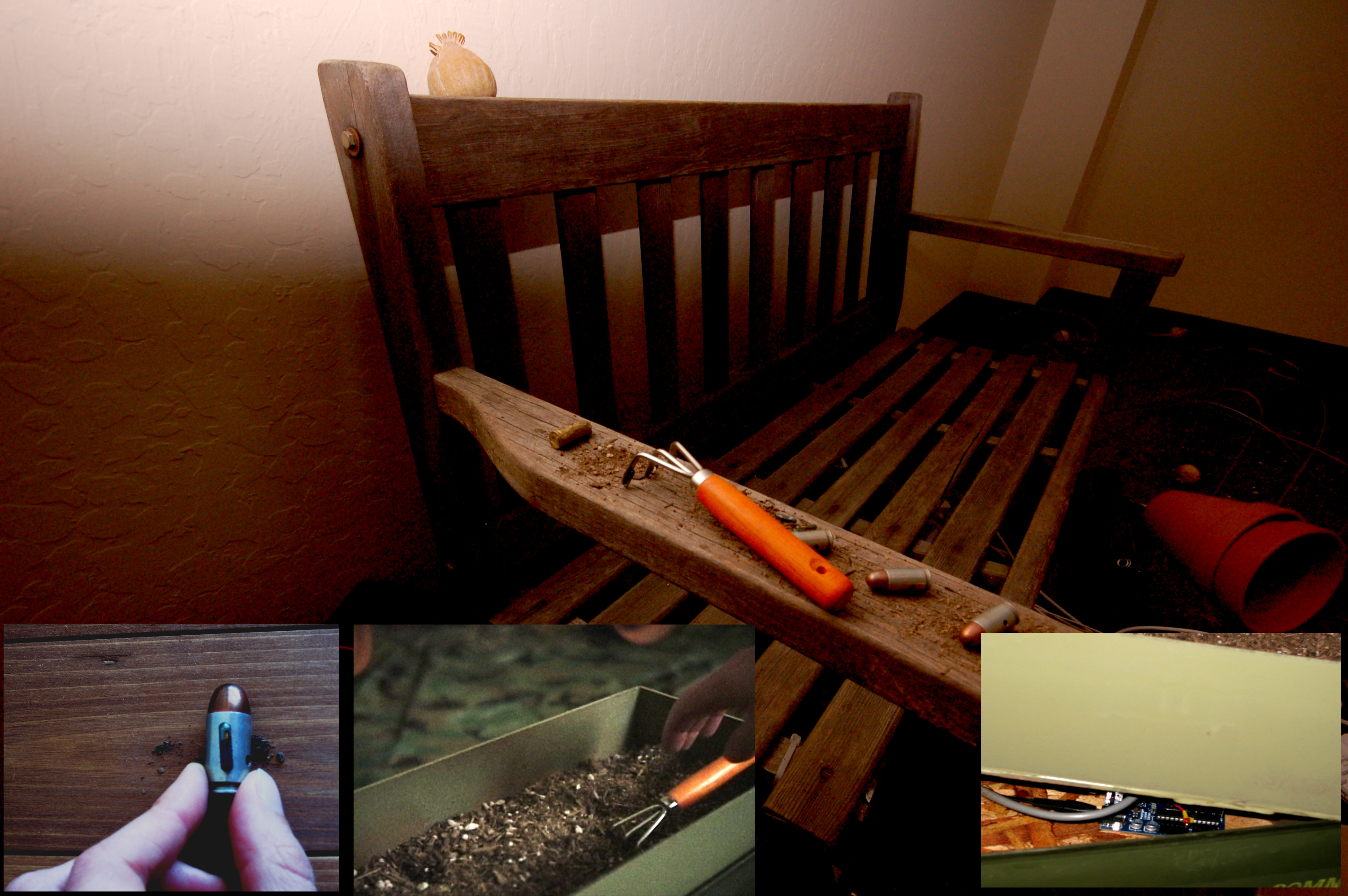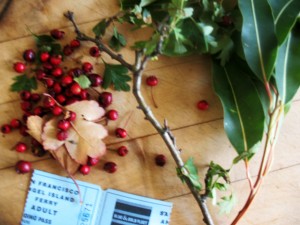Margaretha Haughwout
the birds the bees the flowers and the seeds, 2008-2010
…
the birds the bees the flowers and the seeds is a narrative exploration of the relationship between desire, violence, and the uncanny, set in an installation space that is presented as a future garden. In this piece, a series of spoken fictional “scores” pipe through speakers that double as flower pots. Each of the scores begins with some version of the statement, “It is the future, you live in a future garden. You live in a beautiful garden of the future.” These scores narrate a scenario where, although the garden is very beautiful and you have everything you need, you also miss certain people who are not in the garden, people you love and desire. Or you might need to select new mates to further your species.

Visitors are told that the future garden they find themselves in is a communication technology, or memory device. The audio scores instruct visitors to engage various objects — such as seeds: to place them in the soil, poppy pods: to pull of their tops and toss them, snips: to run over the flowers — as a way to contact a lost love, or select new mates. The RFID-embedded objects and their engagement catalyze a dissociative, and uncanny effect, for the garden’s seeds are actually bullets, the poppy pods, so used, seem like grenades, and the flower snips are actually military wire cutters (indeed, the installation as a whole displays both garden and state military aesthetics). When this piece was shown in the Spring of 2008, the engagement of the various objects that were both garden-like and violent, triggered brief news clips from the current war in Iraq, which temporarily interrupted the narrative scenarios. The initial narrative scenarios introduce plots that revolve around longing, love and memory in an ambiguous, sci-fi future; hence, the triggered war news clips extend and trouble the initial narratives, which are born of deceptive beauty. Desires narrated in the future garden, then, collide with true stories of death and destruction outside the garden, creating deeply uncomfortable associations within the narratives, alluding to the positions and movements of bodies in wired spaces of security and those in violent, unpredictable spaces. It challenges the limits of love. At its most disturbing, the piece asks to what degree the garden — perhaps not metaphorical but very literal — is nourished by this violence.

[audio m4a="http://beforebefore.net/wp-content/uploads/2014/02/1snips2_-natural_mix2.m4a"][/audio]
[audio m4a="http://beforebefore.net/wp-content/uploads/2014/02/2seeds4_-natural_mix2.m4a"][/audio]
[audio m4a="http://beforebefore.net/wp-content/uploads/2014/02/3pods2_-natural_mix2.m4a"][/audio]
[audio m4a="http://beforebefore.net/wp-content/uploads/2014/02/4rake4_-natural_mix2.m4a"][/audio]
Selected Early Work :: 2004-2012
Root City Thorn, 2010
Margaretha Haughwout
Root, City, Thorn, 2010
A conversation while collecting medicinal hawthorn berries from the trees growing beside the old immigration hospital on Angel Island
…
A part of Mary Walling Blackburn’s Radical Citizenship: The Tutorials

on Angel Island and at Southern Exposure
Angel Island:
Friday, September 17th, 2010 10:00 AM to 11:00 AM and 12:00 Noon to 2:00 PM
11:00 AM to 12:00 Noon: Naturalization Ceremony of new U.S. citizens at the U.S. Immigration Station, Angel Island. Sponsored by AIISF, California State Parks, and the U.S. Citizenship and Immigration Services.
The word citizen used to refer a person who lived in a city. Earlier use of the word civilization referred to certain civil practices of citizens, but now has come to signify practices that allowed cities to come about in the first place. We associate civilization with complex agriculture and progress. In my mind, a radical citizen is a person who inhabits the city in such a way that they unravel civilization. To unravel civilization means, at the most fundamental level, to cultivate a diverse array of medicine and food in league with the non-human, to give back to the ecosystem more than one takes, to engage what is growing well in a way that ensures benefit and habitat for the lives of all other humans and non-humans who live nearby. Complexity is fostered through simple action rather than the other way around.
For radical citizenship: the tutorials, we will talk about how certain agricultural practices foster notions of weeds, invasive species and native plants as well as notions of citizen, civility and belonging. The activity of cultivating one’s environment for the benefit of all life will be considered as an ethical activity that dismantles civilization. We will have this conversation while collecting medicinal hawthorn berries from the trees growing beside the old immigration hospital on Angel Island. We will not only collect berries from this tree; we will also care for it. The hawthorn (and possibly other medicinal and edible plants on Angel Island) will be our conversational guide.
A tincture was made with the berries from these trees. We filled gallon sized mason jars and covered them with vodka – later in the fall i strained out the mark and shared with the participants.
See http://welcomedoubleagent.com/2010/radicalcitizenship2.html
the birds the bees the flowers and the seeds, 2008-2010
Margaretha Haughwout
the birds the bees the flowers and the seeds, 2008-2010
…
the birds the bees the flowers and the seeds is a narrative exploration of the relationship between desire, violence, and the uncanny, set in an installation space that is presented as a future garden. In this piece, a series of spoken fictional “scores” pipe through speakers that double as flower pots. Each of the scores begins with some version of the statement, “It is the future, you live in a future garden. You live in a beautiful garden of the future.” These scores narrate a scenario where, although the garden is very beautiful and you have everything you need, you also miss certain people who are not in the garden, people you love and desire. Or you might need to select new mates to further your species.
Visitors are told that the future garden they find themselves in is a communication technology, or memory device. The audio scores instruct visitors to engage various objects — such as seeds: to place them in the soil, poppy pods: to pull of their tops and toss them, snips: to run over the flowers — as a way to contact a lost love, or select new mates. The RFID-embedded objects and their engagement catalyze a dissociative, and uncanny effect, for the garden’s seeds are actually bullets, the poppy pods, so used, seem like grenades, and the flower snips are actually military wire cutters (indeed, the installation as a whole displays both garden and state military aesthetics). When this piece was shown in the Spring of 2008, the engagement of the various objects that were both garden-like and violent, triggered brief news clips from the current war in Iraq, which temporarily interrupted the narrative scenarios. The initial narrative scenarios introduce plots that revolve around longing, love and memory in an ambiguous, sci-fi future; hence, the triggered war news clips extend and trouble the initial narratives, which are born of deceptive beauty. Desires narrated in the future garden, then, collide with true stories of death and destruction outside the garden, creating deeply uncomfortable associations within the narratives, alluding to the positions and movements of bodies in wired spaces of security and those in violent, unpredictable spaces. It challenges the limits of love. At its most disturbing, the piece asks to what degree the garden — perhaps not metaphorical but very literal — is nourished by this violence.

[audio m4a="http://beforebefore.net/wp-content/uploads/2014/02/2seeds4_-natural_mix2.m4a"][/audio] [audio m4a="http://beforebefore.net/wp-content/uploads/2014/02/3pods2_-natural_mix2.m4a"][/audio][audio m4a="http://beforebefore.net/wp-content/uploads/2014/02/1snips2_-natural_mix2.m4a"][/audio]
[audio m4a="http://beforebefore.net/wp-content/uploads/2014/02/4rake4_-natural_mix2.m4a"][/audio]
d.a.t.a.l.o.v.e.r., 2004
Margaretha Haughwout
d.a.t.a.l.o.v.e.r., 2004
…
Participatory narrative and play that uses and science fiction prompts to elicit ephemeral moments of intimacy….